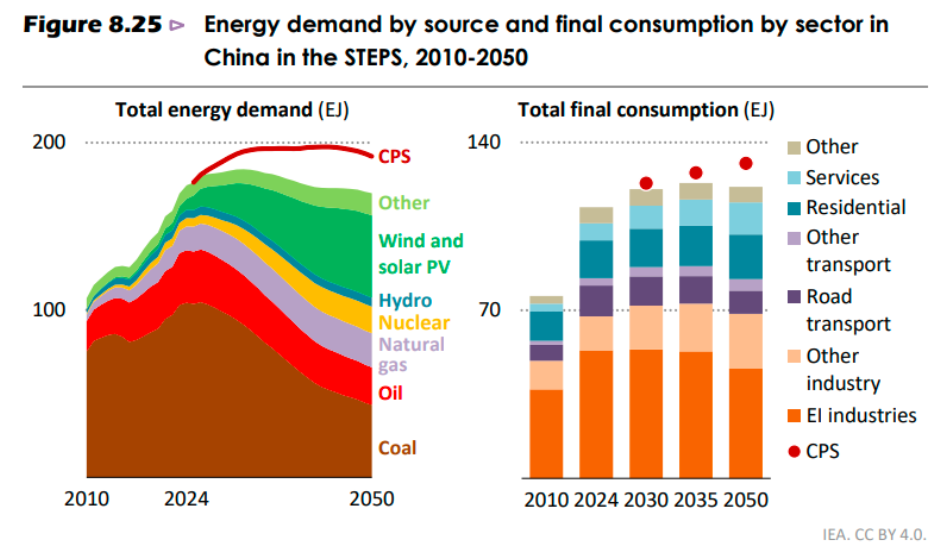China remains the central player in the global energy system, shaping demand, technology, and supply chains. The World Energy Outlook 2025 by the International Energy Agency (IEA) highlights how China’s economy, energy mix, and policy priorities are entering a new phase — from rapid expansion to managed transformation.
The IEA report shows that while China’s overall energy consumption plateaus, it continues to lead in renewables, electrification, and clean technology deployment. Here are ten key takeaways from the report on China’s energy outlook to 2035.
1. China’s Energy Growth Slows as Economy Matures
China’s GDP per capita reached USD 27,000 in 2024, and the nation is set to achieve high-income status in 2025. However, energy demand growth is plateauing as the economy shifts from heavy industry to services and high-value manufacturing. GDP will continue to grow at 3.5 percent annually to 2035, but energy efficiency and structural changes mean total energy consumption peaks before then.
2. Shift Toward a Less Energy-Intensive Economy
Industrial output in energy-intensive sectors such as steel and cement has peaked. Growth now comes from chemicals, non-ferrous metals, and high-tech manufacturing. The transition to a service-oriented economy, combined with increased electrification, leads to a stable energy demand outlook — marking a historic break from decades of rapid energy growth.
3. Electricity’s Share in Final Energy Use Rises Sharply
Electricity already accounts for 27 percent of China’s final energy use and is projected to reach 35 percent by 2035. China is adding around 460 GW of solar and wind capacity annually this decade, making it the largest builder of renewables globally. By 2035, low-emission sources, including renewables and nuclear, will generate more than 10,000 TWh of electricity — exceeding total oil and gas supply combined.
4. Electric Vehicles Reshape Oil Demand
China’s oil demand, once a global growth driver, is expected to decline by 2035. Nearly half of all new car sales in 2024 were electric, and by 2030, EVs will represent over 80 percent of total car sales. Competitive pricing and strong policy support are accelerating the shift, while high-speed rail expansion further reduces oil use in transport. By 2035, total oil demand will be about 15 million barrels per day — 5 percent below current levels.
5. Moderate Growth in Natural Gas Consumption
China’s natural gas demand continues to grow modestly but is constrained by the rapid electrification of end-uses. Gas use in heavy freight trucks and the power sector increases, but industry remains primarily electrified. Total gas demand is projected to reach 630 billion cubic metres by 2035, about 8 percent higher than in the Stated Policies Scenario (STEPS), reflecting limited upside potential.
6. Coal Use Peaks and Declines After 2025
Coal remains the backbone of China’s power system, but demand has peaked. The industrial sector’s coal use has already declined 25 percent since 2014, and another 20 percent fall is expected by 2035. The electricity sector determines coal’s future, with renewables expansion and efficiency gains driving total coal consumption down 20 percent by 2035 in the STEPS scenario.
7. Renewables Outpace the Rest of the World Combined
China is unmatched in renewable energy expansion. In the past five years, it has added more renewables and nuclear capacity than the rest of the world combined. Solar and wind now provide 18 percent of total generation and will continue to rise, adding roughly 480 GW of capacity per year in the STEPS scenario. Renewables manufacturing and cost competitiveness ensure that China remains the global leader in clean energy deployment.
8. Grid Modernisation and Energy Storage Are Priorities
Integrating vast renewable capacity requires stronger grid systems and flexibility solutions. China is investing heavily in pumped hydro, nuclear, and battery storage. Market reforms are also incentivising flexible generation and grid-friendly renewable integration. Even with rising power demand, grid reliability and storage capacity improvements are helping reduce renewable curtailment rates.
9. Balancing Coal Flexibility and Renewable Growth
China still has over 200 GW of coal power capacity under construction, primarily for grid stability and load balancing. Due to lower capital costs, flexible coal operation remains economically viable. The country’s strategy focuses on using coal as a backup rather than a baseload source — a key step in supporting the energy transition while maintaining energy security.
10. China’s Path to a Cleaner, Electrified Future
By 2035, China’s energy mix will be dominated by low-emission electricity sources. Renewables and nuclear will together supply more energy than oil and gas combined. The shift to electrification, coupled with efficiency gains, will reduce carbon intensity, cap total energy demand, and position China as a global leader in decarbonisation technologies — even as it manages complex trade-offs between growth, security, and sustainability.
Conclusion
The World Energy Outlook 2025 underscores that China’s energy future is one of transformation, not expansion. The country’s commitment to electrification, renewable energy, and industrial restructuring signals a decisive move toward sustainability. While challenges remain in balancing coal flexibility and renewable integration, China’s continued leadership in clean technology and grid innovation will be pivotal to global energy and climate outcomes.
Baburajan Kizhakedath

